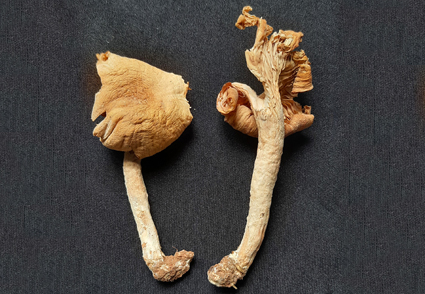Abstract
Panus is a genus of the order Polyporales with a gilled hymenium. Although Panus was earlier considered as a sub genus of the genus Lentinus, molecular phylogenetic studies support the independent status of the genus. As a result, many species were transferred from Lentinus to Panus. Many more species of Lentinus that are more related to Panus, still await critical taxonomic studies and formal transfers. Morphological and molecular data obtained from L. bambusinus and L. roseus reveal that these are Panus species. Two new combinations in the genus Panus are proposed here.
References
Corner, E.J.H. (1981) The agaric genera Lentinus, Panus and Pleurotus. Beiheftezur Nova Hedwigia 69: 1?169.
Drechsler-Santos, E.R., Wartchow, F., Coimbra, V.R.M., Gibertoni, T.B. & Cavalcanti, M.A.Q. (2012) Studies on lentinoid fungi (Lentinus and Panus) from the semi-arid region of Brazil. Journal of the Torrey Botanical Society 139: 437?446. https://doi.org/10.3159/TORREY-D-12-00019.1
Fries, E.M. (1838) Epicrisis systematis Mycologici. E TypographiaAcademica, Uppsala, 610 pp.
García-Sandoval, R., Wang, Z., Binder, M. & Hibbett, D.S. (2011) Molecular phylogenetics of the Gloeophyllales and relative ages of clades of Agaricomycotina producing a brown rot. Mycologia 103: 510–524. https://doi.org/10.3852/10-209
Grand, E.A. (2004) Systematics and species concepts in the genera Lentinus Fr. and Panus Fr., with emphasis on the Lentinus tigrinus, L. crinitus and Panus lecomtei complexes. PhD dissertation, University of Tennessee, 127 pp. [https://trace.tennessee.edu/utk_graddiss/4544]
Hibbett, D.S. & Vilgalys, R. (1991) Evolutionary relationships of Lentinus to the Polyporaceae: evidence from restriction analysis of enzymatically amplified ribosomal DNA. Mycologia 83: 425–439. https://doi.org/10.1080/00275514.1991.12026032
Hibbett, D.S. & Vilgalys, R. (1993) Phylogenetic relationships of Lentinus (Basidiomycotina) inferred from molecular and morphological characters. Systematic Botany 18: 409–433. https://doi.org/10.2307/2419417
Hussein, J.M., Tibuhwa, D.D., Mshandete, A.M. & Kivaisi, A.K. (2014) Molecular phylogeny of saprophytic wild edible mushroom species from Tanzania based on ITS and nLSU rDNA sequences. Current Research in Environmental & Applied Mycology 4: 250–260. https://doi.org/10.5943/cream/4/2/12
Justo, A., Miettinen, O., Floudas, D., Ortiz-Santana, B., Sjokvist, E., Lindner, D., Nakasone, K., Niemelä, T., Larsson, K.H., Ryvarden, L. & Hibbett, D.S. (2017) A revised family-level classification of the Polyporales (Basidiomycota). Fungal Biology 121: 798–824. https://doi.org/10.1016/j.funbio.2017.05.010
Karunarathna, S.C., Yang, Z.L., Zhao, R.L., Vellinga, E.C., Bahkali, A.H., Chukeatirote, E. & Hyde, K.D. (2011) Three new species of Lentinus from northern Thailand. Mycological Progress 10: 389–398. https://doi.org/10.1007/s11557-010-0701-6
Kühner, R. (1980) Les Hyménomycètes agaricoides. Bulletin Mensuel de la Société Linnéenne de Lyon 49: 1?1027. https://doi.org/10.3406/linly.1980.10422
Kumar, T.K.A. & Manimohan, P. (2005) A new species of Lentinus from India. Mycotaxon 92: 119?123.
Kumar, S., Stecher, G., Li, M., Knyaz, C. & Tamura, K. (2018) MEGA X: Molecular evolutionary genetics analysis across computing platforms. Molecular Biology and Evolution 35: 1547?1549. https://doi.org/10.1093/molbev/msy096
Macherey-Nagel (2014) NucleoSpin® Plant II: Genomic DNA from Plant User manual, June 2014/Rev.03. Macherey-Nagel GmbH & Co. KG. Düren.
Miettinen, O., Larsson, E., Sjökvist, E. & Larsson, K.H. (2012) Comprehensive taxon sampling reveals unaccounted diversity and morphological plasticity in a group of dimitic polypores (Polyporales, Basidiomycota). Cladistics 28: 251–270. https://doi.org/10.1111/j.1096-0031.2011.00380.x
Moreno, G., Blanco, M.N., Checa, J., Platas, G. & Peláez, F. (2011) Taxonomic and phylogenetic revision of three rare irpicoid species within the Meruliaceae. Mycological Progress 10: 481–491. https://doi.org/10.1007/s11557-010-0717-y
Njouonkou, A., Mossebo, D.C. & Akoa, A. (2013) The genera Lentinus and Panus in the Dja Biosphere Reserve and its periphery, Cameroon. Kew Bulletin 68: 517–521. https://doi.org/10.1007/s12225-013-9461-1
Njouonkou, A., Watling, R. & Degreef, J. (2013a) Lentinus cystidiatus sp. nov. (Polyporaceae): an African lentinoid fungus with an unusual combination of both skeleto-ligative hyphae and pleurocystidia. Plant Ecology and Evolution 146: 240–245. https://doi.org/10.5091/plecevo.2013.792
Pegler, D.N. (1983) The genus Lentinus: a world monograph. Kew Bull Add Ser 10, 281 pp.
Redhead, S.A. & Ginns, J. (1985) A reappraisal of agaric genera associated with brown rots of wood. Transactions of the Mycological Society of Japan 26: 349?381.
Rune, F. (1994) Neolentinus-a well-founded genus in Pleurotaceae that includes Heliocybe. Mycological Research 98: 542?544. https://doi.org/10.1016/S0953-7562(09)80476-0
Seelan, J.S.S., Justo, A., Nagy, L.G., Grand, E.A., Readhead, H.A. & Hibbett, D. (2015) Phylogenetic relationships and morphological evolution in Lentinus, Polyporellus and Neofavolus, emphasizing southeastern Asian taxa. Mycologia 107: 460–474. https://doi.org/10.3852/14-084
Senthilarasu, G. (2015) The lentinoid fungi (Lentinus and Panus) from Western Ghats, India. IMA Fungus 6: 119–128. https://doi.org/10.5598/imafungus.2015.06.01.06
Senthilarasu, G. & Singh, S.K. (2012) A new species of Lentinus from India. Mycotaxon 121: 69–74. https://doi.org/10.5248/121.69
Singer, R. (1951) The Agaricales (Mushrooms) in modern taxonomy. Lilloa 22: 1–832.
Singer, R. (1975) The Agaricales in modern taxonomy. 2<sup>nd</sup> Ed. A. R. Gantner Verlag KG., Germany, 912 pp.
Singer, R. (1986) The Agaricales in modern taxonomy, 4<sup>th</sup> ed. Germany: Koeltz Scientific Books, 981 pp.
Tamura, K. & Nei, M. (1993) Estimation of the number of nucleotide substitutions in the control region of mitochondrial DNA in humans and chimpanzees. Molecular Biology and Evolution 10: 512?526.
Thorn, R.G., Moncalvo, J.M., Reddy, C.A. & Vilgalys, R. (2000) Phylogenetic analyses and the distribution of nematophagy support a monophyletic Pleurotaceae within the polyphyletic pleurotoid?lentinoid fungi. Mycologia 92: 241–252. https://doi.org/10.2307/3761557
Zmitrovich, I.V. (2018) Conspectus systematis Polyporacearum v. 1.0. Folia Cryptogamica Petropolitana 6: 3?145.
Zmitrovich, I.V. & Kovalenko, A.E. (2016) Lentinoid and polyporoid fungi, two generic conglomerates containing important medicinal mushrooms in molecular perspective. International Journal of Medicinal Mushrooms 18: 23?38. https://doi.org/10.1615/IntJMedMushrooms.v18.i1.40


